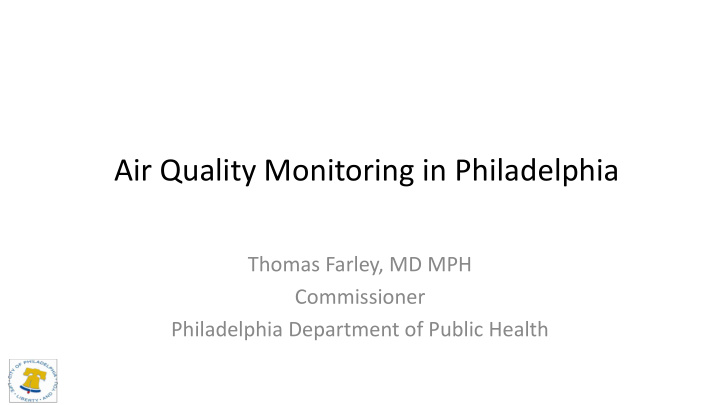



Air Quality Monitoring in Philadelphia Thomas Farley, MD MPH Commissioner Philadelphia Department of Public Health
Air Pollution • EPA “Criteria” Pollutants • “Air Toxics” – Particulate Matter (PM2.5 and PM10) – Chemicals that may have long-term risks for cancer or other biologic/environmental – Nitrogen dioxide (NO 2 ), Ozone (O 3 ), Carbon • E.g. benzene, formaldehyde monoxide (CO), Sulfur dioxide (SO 2 ) – Produced by chemical release (e.g. – Lead gasoline stations, dry cleaners) • Harmful to human health • Greenhouse gases – Heart and lung disease, reduced life expectancy • Carbon dioxide (CO 2 ), Methane (CH 4 ), Nitrous oxide (N 2 O) • Mainly produced by combustion • Flourinated gases like hydroflourocarbons – Stationary sources – Produced by burning, production, • PES and other industrial sources transport of fossil fuels • Building furnaces and boilers – Contribute to global warming, climate – Mobile sources change, severe weather events, sea level rise • Cars, trucks, buses • Ships, airplanes, construction equipment
Air Quality Has Improved Since Regulation 1962 2010s
City-Wide Air Monitoring Network
Trends in Annual PM2.5 (Fine Particles) 20 20 18 18 16 16 14 14 CONCENTRATION (ug/m3) 12 12 10 10 8 8 6 6 4 4 2 2 0 0 2001 2002 2003 2004 2005 2006 2007 2008 2009 2010 2011 2012 2013 2014 2015 2016 2017 2018 YEAR MIN AVG MAX ANNUAL NAAQS (12 ug/m3)
Trends in Annual Ozone
Source: Philadelphia Inquirer, 6-29-2019 (https://www.inquirer.com/business/philadelphia- refinery-fire-plan-to-close-20190626.html)
Sources of Air Pollution at PES • Distillation Unit • Cracking units • Alkylation Unit • Sulfur recovery unit • Pumps, air compressor, fans • Catalytic reforming unit • Steam generating boilers • Hydrogen production unit • Process heaters • Storage tanks • Flares • Wastewater treatment • CO Boilers
Monitoring of Emissions from PES • Stack tests when source is installed or modified and generally repeated every 5 years. • Continuous Emission Monitors (CEMs) that measure certain pollutants on continuous basis – Quarterly reports submitted to AMS -> DEP, EPA • Inspections by AMS and EPA • Fence line air monitors: – Particulate matter (PM2.5 and PM10), ozone, S0 2 , lead, CO, NOx, H 2 S – Benzene
Estimated emissions from PES vs. other sources in Philadelphia Fine Particles (PM2.5) Greenhouse Gases* Other PES stationary 9% PES sources 20% 5% Other stationary sources 8% Mobile sources 72% Mobile sources 86% *Including carbon dioxide, methane, and nitrous oxide Stationary sources estimated by measurement and reports; mobile sources estimated by EPA MOVES14a model
City-Wide Air Monitoring Network
PM2.5 Concentration (ug/m3) 10 15 20 25 30 35 40 45 50 0 5 1/1/2014 2/20/2014 4/11/2014 5/31/2014 7/20/2014 9/8/2014 10/28/2014 12/17/2014 PM2.5 at RIT Station 2/5/2015 3/27/2015 5/16/2015 7/5/2015 8/24/2015 Daily Average of PM2.5 at RIT Station 10/13/2015 12/2/2015 (1/1/2014 - 6/24/2019) 1/21/2016 3/11/2016 4/30/2016 6/19/2016 8/8/2016 9/27/2016 11/16/2016 1/5/2017 2/24/2017 4/15/2017 6/4/2017 7/24/2017 9/12/2017 11/1/2017 12/21/2017 2/9/2018 3/31/2018 5/20/2018 7/9/2018 8/28/2018 10/17/2018 12/6/2018 Fire/Explosion 1/25/2019 3/16/2019 5/5/2019 6/24/2019
Fine Particle Pollution at PES and Nearby Stations On Morning of Fire/Explosion 70 60 50 PES Fenceline 40 Ug/m3 30 20 RIT station Camden 10 0 0:00 1:00 2:00 3:00 4:00 5:00 6:00 7:00 8:00 9:00 10:00 Time, June 21, 2019
Philadelphia Air Quality Survey Sampling Units
Annual Average PM2.5 in Monitoring Sites Preliminary Results from PAQS Roxborough 6.5 City Average 8.1 ug/m 3 City Hall 10.4 Southwest 8.3 24 th + Ritner 7.9 Refinery
Summary • Air pollution levels in Philadelphia far lower than previously, but further improvements would help human health • PES is a significant source of air pollution and greenhouses gases in Philadelphia – Mobile sources (vehicles and equipment) are cumulatively far greater contributors • Levels of PM2.5 in neighborhoods near PES similar to city-wide average • No evidence that fire/explosion on June 21 increased levels of air pollutants in neighborhoods nearby
Recommend
More recommend